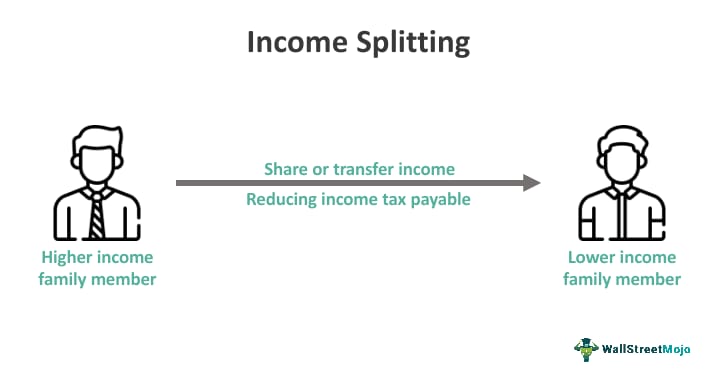Table Of Contents
What Is Income Splitting?
Income splitting is a tax policy that enables higher-income family members to redistribute passive and earned income to their lower-earning counterparts, thereby reducing the overall tax burden. This practice enhances family tax efficiency, raises the post-tax income of lower-earning members, and promotes equitable income distribution.

Families with disparate earnings or significant income gaps often utilize income splitting when filing separate income tax returns. This can be achieved through various methods, including splitting pension, lending to a family trust, attributing investment or business income to a minor child, and transferring tax credits.
Key Takeaways
- Income splitting involves higher-earning family members shifting their passive and earned income to lower-earning members.
- It provides legal tax savings through various options, including spousal transfers, pension sharing, and leveraging the progressive tax system, resulting in lower overall family tax burdens.
- This strategy lowers the family's tax burden, increases the post-tax income of lower-earning members, and promotes a more equitable income distribution.
- Techniques such as sharing pensions, transferring assets, utilizing trusts, allocating business income,
- and contributing to spousal RRSPs are employed within the Canada Revenue Agency (CRA) regulations to minimize taxes for Canadian families.
How Does Income Splitting Work?
Income splitting refers to the redistribution of income of higher-earning family members to the lower-earning member. It involves strategic approaches for multiple individuals to distribute income or property business revenues, reducing overall tax liability by leveraging lower tax brackets. In Canada, it has become integral to financial planning, with recent expansions to income splitting rules by the Canada Revenue Agency (CRA) covering interest, capital gains, or dividends paid to individuals by related entities.
Legal means are employed to capitalize on lower tax brackets, often by allocating investments or income-producing assets to lower-earning family members. This strategy, including spousal contributions, gifts, trusts, or family joint ventures, decreases the overall family tax obligation and boosts the wealth of lower-earning members, enhancing their financial security.
Income splitting requires careful navigation of attribution rules and adherence to tax laws. Seeking guidance from a tax consultant, lawyer, or financial advisor is recommended to ensure compliance and avoid legal implications. Its applicability depends on regional tax laws and may be subject to regulatory limitations. Proper documentation and understanding of eligibility criteria are essential to implement income-splitting strategies while staying within legal boundaries successfully.
Strategies
Income splitting strategies aim to optimize tax burdens and maximize family savings and wealth. Key approaches include:
- Pension Income Splitting: Distributing pension income among spouses or common-law partners as per CRA regulations.
- Transferring Assets or Investments: Moving funds or assets to a lower-income family member to leverage reduced tax rates.
- Family Trusts: Establishing trusts to distribute funds to family members' beneficiaries, facilitating revenue sharing.
- Employment Income Splitting: Balancing tax responsibilities in family enterprises by allocating salaries or income among participating family members.
Examples
Let us use a few examples to understand the details of the topic:
Example #1
Suppose John and Lisa Smith are a Canadian couple looking to optimize their retirement income. John, the higher earner, decides to split his pension income with Lisa. By doing so, they effectively reduce their combined tax liability. Lisa, the lower earner, benefits from a lower tax rate on the shared pension income, boosting their overall after-tax income. This approach allows the Smiths to achieve a more balanced distribution of their retirement funds, enhancing their financial well-being.
Example #2
Imagine Mark and Emily Johnson, a family with diverse investment portfolios. Mark, as the primary investor with a higher passive income, decides to implement income splitting by allocating a portion of his dividend income to Emily, who has a lower income. This helps lower their tax burdens and takes advantage of Emily's lower tax bracket. By adhering to tax regulations and distributing dividends strategically, the Johnsons successfully optimize their overall tax efficiency while ensuring a fair distribution of their investment gains.
Advantages
Income splitting significantly relieves lower-income family members and alleviates the overall tax burden. Key advantages include:
- Tax Savings: A higher-earning spouse can transfer funds to their lower-tax-bracket partner, reducing the family's total tax liability.
- Progressive Tax System: In Canada, leveraging the progressive tax system enables income distribution to lower-income family members, lowering the family's taxable income.
- Eligible Income: Applicable to various income sources, including life annuities, Registered Retirement Income Funds (RRIF), and Registered Retirement Savings Plans (RRSP).
- Legal and Regulated: Legally accepted in Canada, income tax splitting is a valid method of reducing tax obligations.
- Pension Splitting: Couples can divide qualifying pension income, potentially decreasing the family tax burden.
- Pension Credit Splitting: Dividing Canada Pension Plan credits aids separated or divorced spouses in qualifying for benefits.
- Tax Planning Strategy: Functions as a tax-planning technique, optimizing tax savings by shifting income from a higher tax bracket to a lower one.
- Reduced Tax Liability: Particularly advantageous when there's a significant income disparity between spouses, leading to substantial tax savings.
